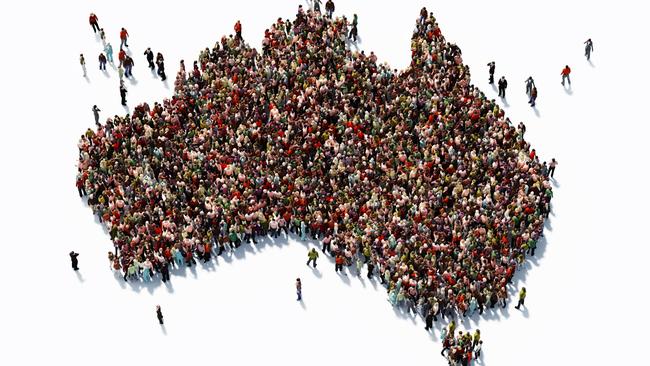
Until now, I have been largely barking at the moon as both the federal and most state governments endorsed high rates of population growth.
There have been numerous reasons for this, but there has been little deviation from the enthusiasm for the policies that deliver one of the highest rates of population growth among developed economies. Last year our population grew about 1.5 per cent; in the US it was 0.5 per cent.
We also have one of the highest percentages of overseas-born in the population. Last year, 7.5 million of us were from overseas, close to 30 per cent. While England is the single largest country of birth, those numbers have been falling. China is the second-largest country of birth with 677,000, or 2.7 per cent of the population. India is not far behind, with 660,000.
With population growth about 400,000 annually, net overseas migration has accounted for more than 60 per cent of it. Now, 400,000 is like adding a city the size of Canberra every year. Little wonder that population pressures have been a concern to many Australians.
Some important figures were released by the Australian Bureau of Statistics last month. They underscore how the government had failed to bring net overseas migration under control. Based on people staying at least 12 months over a 16-month period, NOM is the difference between net overseas arrivals and net overseas departures.
The ABS summarises the position as follows: “Overseas migration to and from Australia (in the year ending in June) resulted in a net increase to Australia’s population of 239,600 people. Temporary visa holders were the majority of overseas migrant arrivals (63.4 per cent).”
Of those on temporary visas, the largest group was for higher education — 118,000. Vocational education and training visa entrants were a further 22,000. Only 83,000 entered on permanent visas, with those in the skilled category making up just 7 per cent of total migrant arrivals.
It’s one of the reasons the government’s reluctant commitment to reduce the permanent migrant intake from 190,000 to 160,000 was meaningless. With permanent visas making up less than 16 per cent of arrivals, the real action is with temporary visas.
And those on temporary visas can stay for many years. Graduates of Australian universities, for instance, are entitled to various visas that allow them to work for several years. It is also common for temporary visa holders to apply for permanent visas in due course, using both the skill and family categories.
Migration has been out of control for more than a decade. The NOM has jumped from about 100,000 per year in the mid-2000s to average about 250,000 ever since.
The federal Treasury has a warped view that high immigration is necessary for economic growth and to underpin taxation revenue. Of course, in an arithmetic sense, higher population growth is associated with higher GDP growth. But living standards are underpinned by per capita GDP growth and, on this measure, living standards have stalled over a decade or so — notwithstanding our terms of trade being relatively high over much of it.
The boasting about continuous economic growth for more than a quarter of a century is really a statement of the population having grown so rapidly. If we look at per capita GDP growth there have been three significant dips in that period — not counting this year.
Another fundamental flaw of Treasury is its failure to account for the fiscal costs, largely borne by the states and territories funding infrastructure, public transport and new public services. Costs go beyond budget outlays. For residents of the larger cities — Melbourne and Sydney are the most popular with international students — they include loss of urban amenity, substandard high-rise developments and congestion. Neither Treasury nor most politicians take these into account.
Many state governments endorse excessive population as it spurs property transactions and pumps up stamp duty revenue. And most state governments are attracted to increased infrastructure spending — lots of photo opportunities with high-vis jackets and hard hats.
Universities and other educational providers are part of the cheer squad for unfettered entry of international students as well as support for the liberal allocation of post-graduation visas to encourage students to come.
Using the very wobbly rationale that the federal government does not fund higher education appropriately — how long is that piece of string? — unis have become addicted to international student fees. That some enrolled more international students than domestic last year underscores how out of hand it is. That party has come to a screeching halt with international student numbers dropping, and the prospect of larger declines in the second half. It’s hard to see much recovery in part because the economies of the principal source countries will have been seriously weakened.
The NOM total will fall dramatically — one estimate suggests a fall of almost 85 per cent for the year ending in June. Low numbers will persist into next year. There are still advocates of a big Australia including, unsurprisingly, from the property sector and some academics. But their dream of having hundreds of thousands of migrants coming every year may not be fulfilled, at least for some time.
For many this will be a relief — less congestion, more seats on public transport, lower property prices and rents. Some ambitious infrastructure plans to make up for assumed shortfalls may need to be re-evaluated. Unis will need to adjust, but focusing more on domestic students is welcome.
The federal government needs much lower population growth targets. Net migration should contribute no more than 20 per cent of growth in any year. Promoting economic growth through excessive population growth has been the lazy way — and it should be rejected.







We all have our pet issues. One of mine is our excessive rate of population growth driven principally by international students and other temporary migrants.